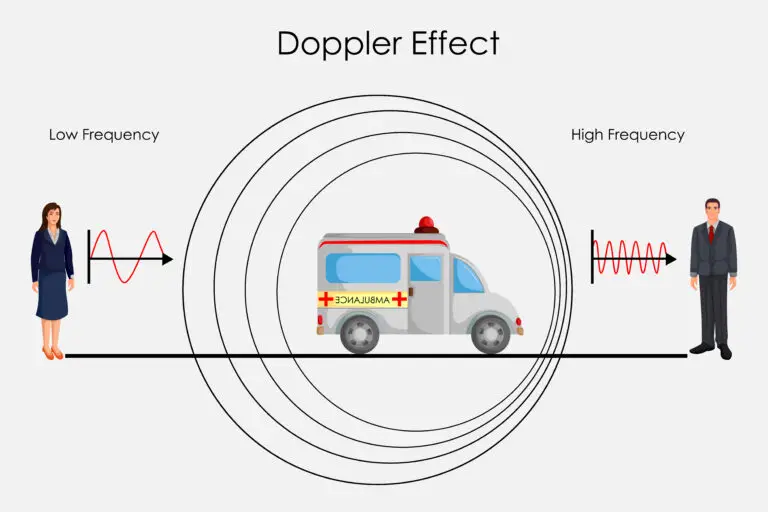Doppler Effect

Table of Contents
What is the Doppler Effect?
The Doppler effect, or Doppler shift, is a key concept in wave physics that describes a wave’s change in frequency or wavelength as observed when the source of the wave and the observer are in motion relative to each other. This effect can be experienced in different contexts.
Sound Waves: A common everyday example of the Doppler effect is the change in pitch of a siren as an ambulance passes by. As the ambulance approaches, the sound waves become compressed, leading to a higher frequency or pitch, which is why the siren sounds higher. As it moves away, the waves are stretched out, resulting in a lower frequency or pitch, and the siren sounds lower.
Light Waves: In astronomy, the Doppler effect determines the movement of stars and galaxies. If a celestial object moves toward Earth, its light waves are compressed, causing a blue shift (an apparent shift to shorter wavelengths). Conversely, if the object moves away, its light stretches out, resulting in a redshift (a shift to longer wavelengths).
Doppler Effect Principles
The basic principle of the Doppler effect lies in the relative motion between a wave source and an observer, leading to a perceived change in the frequency of the waves. This change occurs due to the compression or stretching of wavefronts as they reach the observer, which is directly related to the motion of the source and/or the observer.
Compression of Wavefronts
When the source of the waves moves towards the observer, the wavefronts are compressed, increasing the frequency of the waves received by the observer. This compression means that the waves arrive at the observer more frequently, resulting in a higher perceived pitch in the case of sound or a shift to the blue end of the spectrum in the case of light.
Stretching of Wavefronts
Conversely, when the source moves away from the observer, the wavefronts are stretched apart, causing a decrease in the frequency of the waves that reach the observer. This stretching means the waves arrive less frequently, resulting in a lower perceived pitch for sound or a shift to the red end of the spectrum for light.
Types of Doppler Effect
For Sound Waves
For sound waves, the Doppler effect has a noticeable impact on the perceived pitch of the sound as the distance between the source and the observer changes. This change in pitch or frequency occurs due to the relative motion between the source of the sound and the observer:
Approaching Source: When the source of the sound moves closer to the observer, the sound waves in front of the source are compressed, leading to an increase in the frequency of the waves that reach the observer. This compression causes the observer to perceive a higher pitch than the sound produced at the source. For example, as a police car with a siren approaches, the siren’s pitch sounds higher to an observer standing on the sidewalk.
Receding Source: Conversely, when the sound source moves away from the observer, the sound waves are stretched, increasing the wavelength and decreasing the frequency of the waves that reach the observer—this stretching results in the observer perceiving a lower pitch than the sound produced at the source. After the police car passes and moves away, the siren’s pitch sounds lower to the observer.
For Light Waves
The Doppler effect impacts light waves, manifesting as a shift in their observed color or wavelength, a phenomenon extensively used in astronomy to study the motion of celestial bodies. By analyzing the extent of redshift or blueshift in the light from celestial objects, astronomers can determine their relative speed and direction of motion with respect to Earth.
Redshift and Blueshift
The basic principle of the Doppler effect lies in the relative motion between a wave source and an observer, leading to a perceived change in the frequency of the waves. This change occurs due to the compression or stretching of wavefronts as they reach the observer, which is directly related to the motion of the source and/or the observer.
Redshift
When a celestial object, such as a galaxy or star, is moving away from Earth, the light it emits experiences an increase in wavelength as it reaches us, shifting it toward the red end of the light spectrum. This shift, known as redshift, indicates that the object is receding from the observer. Redshift is particularly significant in cosmology, providing evidence for the universe’s expansion. Observations of distant galaxies reveal that their light is redshifted, which has led to the conclusion that the universe is expanding, with galaxies moving away from each other.
Blueshift
Conversely, when a celestial object moves toward Earth, the wavelengths of the light it emits are compressed, shifting the light toward the blue end of the spectrum. This phenomenon, known as blueshift, indicates that the object is approaching the observer. Blueshift is less commonly observed in astronomy than redshift, mainly because most galaxies are moving away from us due to the overall expansion of the universe. However, blueshift can be observed in objects within our galaxy, the Milky Way, as they move closer to us.
Related Links
Amplitude (Physics)
Diffraction
Refraction
Sound